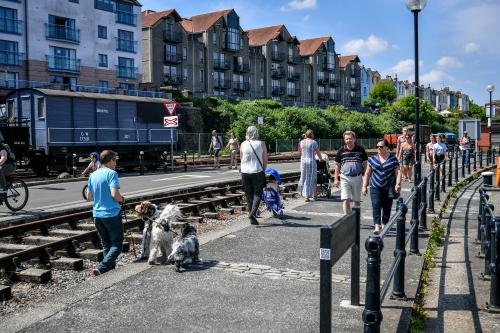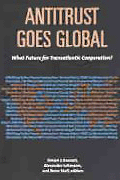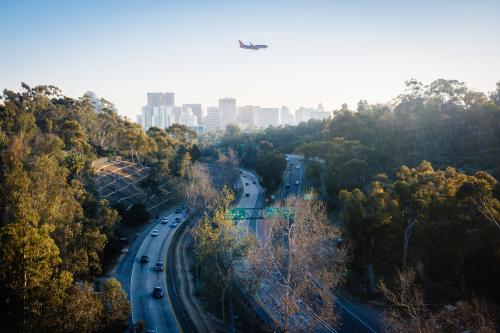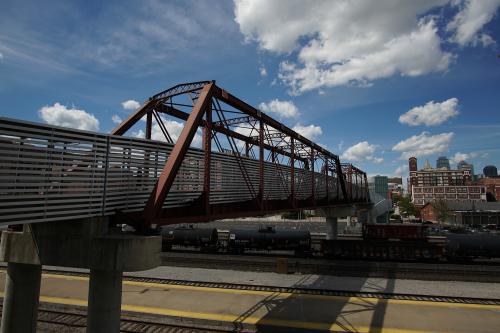On March 27, Mayor Eric Garcetti virtually convened 45 mayors from around the world to share their experiences responding to COVID-19 as it rippled throughout the world. These mayors were part of C40 Cities, a network of 96 of the world’s largest cities focused on fighting the climate emergency.
Two weeks earlier the World Health Organization (WHO) had declared the outbreak a pandemic. The C40 quickly repurposed from its focus on tackling climate change to leverage its relationships, capacity, and expertise with cities to facilitate their leadership on the front lines of the response to COVID-19. In short order it rolled out a knowledge base, set up a recovery task force chaired by Mayor Beppe Sala of Milan, and signed up an influential set of global cities to make issues of equity and climate action central to COVID-19 response and recovery.
This is just one example of the diverse global activity and collective action facilitated by city-to-city networks since the onset of COVID-19. It stands in stark contrast to the challenges experienced by the traditional, nation-state multilateral system in facilitating global cooperation to address the crisis. Indeed, the difficulties traditional institutions have faced in providing a coherent and timely response to the pandemic accelerated the impulse for rapid city-to-city cooperation. This instinct was also intensified by the lackluster reaction by many national governments in providing guidance, coordination, and resources within their own countries. Cities and local governments banded together to move forward quickly and decisively.
The prevailing view is that cross-border collaboration and experience sharing among city officials reflect a type of global cooperation based primarily on pragmatism and problem-solving, rather than geopolitical interests, which differentiates it from traditional multilateralism. What is the COVID-19 crisis revealing about this thesis and the value, limitations, and likely evolution of global city-to-city cooperation?
1. What are cities doing through city-to-city cooperation during COVID-19 response?
Complementing direct bilateral relationships, a large part of city-to-city cooperation is structured through city networks, whose number has grown exponentially since the 1980s, estimated to total about 300 today. Each network emerged primarily to respond to a specific demand, with the resulting ecosystem encompassing a wide range of specific objectives and aspirations. Some seek to create a political forum for dialogue, cooperation, and knowledge sharing, such as the United Cities and Local Governments (UCLG), which supports an “international municipal movement.” Others focus on specific sectors or topical areas, such as climate change (C40 Cities), resilience (Global Resilient Cities Network), and migration (Mayors Migration Council).
The pandemic catalyzed initiatives at the national, regional, and global levels. In the United States, the U.S. Conference of Mayors conducted a key survey of cities and facilitated collective advocacy to Congress for additional emergency COVID-19 relief. The mayors of Buenos Aires, Bogotá, Lima, Madrid, Montevideo, and Santiago de Chile, all members of the Union of Ibero-American Capital Cities (UCCI), met virtually to share viewpoints and tactics to address the crisis. But many initiatives to support local action have had a global ambition, such as the Beyond the Outbreak platform created by UCLG, Metropolis, and UN-Habitat.
Certain cities belong to multiple networks; others may not belong to any. The decision to engage in city-to-city cooperation varies by their size, staff capacity and resources, and global ambition. The COVID-19 crisis is further forcing city officials to be selective about their engagement. Based on conversations with cities, the most often cited reasons for engaging in international cooperation in response to the pandemic include:
- Economic and material benefits. Various cities activated bilateral relations to procure masks. Milan received masks from Wuhan, Bristol from its twin city Guangzhou, Madrid from Chongqing and others, and Yokohama and Shanghai exchanged mask donations when each was experiencing its peak. As more cities reopen, they are beginning to rely on international relations to improve their economic resilience, as they reinforce trade and investment interactions with counterparts. They are creating innovative city-to-city or metro-to-metro economic partnerships, or holding virtual trade missions like Glasgow in Shanghai and Hangzhou.
- Exchange of experience and expertise. Cities immediately turned to their peers and city networks to find templates for policies and communications, and to share lessons and experiences through networks, clearinghouses, and knowledge bases. For example, Metropolis and UCLG launched the Cities For Global Health platform to foster exchange on managing the health aspects of the crisis. In the United States, Bloomberg Philanthropies supported the National League of Cities to create a “Local Action Tracker,” and hosted high-level expert meetings with mayors that eventually included global counterparts. In Europe, Eurocities collated best practices on its CovidNews platform. Such examples are only a few of the wide variety of public and private webinars, seminars, and roundtables featuring experts and high-level political leaders hosted by different organizations within the ecosystem of city networks.
- Advocacy and influence. Cities are raising a collective voice to influence and advocate for support from other levels of government and global financial institutions. While this had been happening pre-COVID-19, the pandemic—and the halting international and national responses that have accompanied it—has created more urgency. The Urban 20 (U20), launched three years ago to provide an urban perspective on the G-20’s deliberations, is launching a special working group on financing, seeking to elevate the fiscal challenges and dependencies that cities will experience during the recovery. On July 15, the C40 Task Force released an Agenda for Green and Just Recovery, with a list of recommended actions and demands for national governments and global financial institutions. In the European Union, a group of cities is advocating through the Eurocities network in coordination with the Committee of the Regions and the Cohesion Alliance for direct access to EU relief funding and the reduction of European fiscal barriers that hinder long-term infrastructure investments.
2. How are cities managing their international engagement?
Given the pressures of COVID-19 response, the multiplicity of networks and opportunities, and the limits on resources and staff, cities are beginning to take steps to rationalize their selection and involvement in city networks. The pressures of the pandemic are creating an incentive to:
- Be more selective. Now more than ever, city leaders are finding it helpful to develop a clear strategy around the scope of international engagement that best matches their city’s needs. A set of criteria and goals are helping cities decide the type of cooperation and particular networks that offer the best potential to be most helpful. As noted by a senior international affairs official for the city of Helsinki, cities may adjust their engagement accordingly as their needs evolve. During the immediate pandemic response, Helsinki benefited from health-related networks, like the WHO’s Healthy Cities and the Bloomberg Philanthropies Coronavirus Global Response Initiative, to obtain specific expertise and information, such as contact tracing As the city prepares to address the long-term social and economic effects of the crisis, Helsinki will likely shift to invest more time and energy in networks working on economic recovery or facilitating connections to funding, such as the World Economic Forum’s Future Council of Cities or Eurocities.
- Seek to build trusting relationships with peers. Cities see value in informal, ad hoc, and opportunistic exchanges as well as more formal, long-term, and costly commitments to city networks. In the early days of COVID-19 response, for example, ad hoc networks emerged with a group of city leaders helping each other via a WhatsApp chat group. Given their propensity to use both modalities, cities may prioritize networks that focus on building close, candid, and trusting relationships with peers that can be leveraged to share valuable information no matter the context or issue.
- Identify the right internal resources. Some cooperation platforms and networks require engagement by the mayor or top strategy advisers to give them political weight. But often, change happens at the expert or technical levels (finance, health, international trade, infrastructure, transportation) or even beyond local government (community foundations, universities, utilities). To strike the right balance, cities benefit from an internal process and clarity on which staff are best positioned to actively engage and therefore maximize benefits from what any one network has to offer, argues a senior international affairs official for the Bristol City Council. Appetite is also growing to access training for technical staff and nonelected officials to enable continuity of engagement across political cycles.
3. How might city networks evolve?
The creation of city networks has been mostly demand-driven, to meet unique needs in specific sectors or regions. While this provides networks with legitimacy and credibility from their members, it also means city networks have proliferated, creating a fragmented market We might expect city networks to evolve post-COVID along these lines:
- Provide clear value. Cities have been prioritizing networks that provide them with tangible benefits for their most urgent needs: health resilience, housing, sustainability and climate, etc. Networks with a high-demand specialty, or positioned to provide meaningful engagement on urgent issues, may be seen as a higher priority versus general-purpose networks geared toward international municipalism. As COVID-19 laid bare the deep inequalities within cities, cooperation and exchange to “build back better” and create more equitable, just, and resilient communities are already emerging as top demands from cities looking for value in their networking.
- Avoid redundancy. The various membership bases allow some degrees of market segmentation between networks: For instance, Metropolis and C40 cater mainly to larger cities while ICLEI (Local Governments for Sustainability) connects smaller ones together. But city leaders also describe an increasingly crowded field of networks offering information, services, and opportunities for collaboration, sometimes on redundant topics and activities. This creates various and rich learning opportunities, but fatigue and confusion are creeping in for city leaders managing a myriad of engagement and webinar opportunities. Over the next several years, the COVID-19 era might well usher in an era of consolidation and sharper differentiation. The stronger networks are increasingly finding synergies and coordinating their activities together.
- Expand the diversity of connected cities. Facing resource constraints, whether budget, staff, or time, many cities—particularly small or mid-sized cities, or those located in emerging countries—are not engaging or benefiting from city networks at the same level as their peers. Currently, resources for city international engagement are generally less than 1 percent of city budget. In addition, some cities are better able to leverage philanthropic funding or support from a regional multilateral institution, such as the EU, to promote their interests. This is creating inequities (perhaps unintended) among cities regarding access to international cooperation. There is a growing bifurcation among globally fluent cities, with visible leaders well-connected to city networks, and others that remain mostly outside these circles. The pandemic has motivated certain networks such as GRCN, C40, and UCLG to expand their reach to nonmembers, but it remains unclear the extent to which networks will be asked or expected to broaden their membership and offerings to remain legitimate from the perspective of nonmembers and other stakeholders.
- Elevate a collective city—rather than institutional—perspective. As cities engage in international cooperation to learn from each other and raise a collective voice, there is a risk that the branding of particular networks or their institutional partners gains prominence over the voice of cities. The legitimacy of these networks stems from the cities that are members, and there will remain an imperative for city leadership—rather than network secretariats—to set the direction and ensure that the focus of their networks serves the needs of cities at the tactical and operational levels. As the landscape of networks evolves, they would be wise to remain wary of mirroring the formality and bureaucracy of traditional multilateral platforms.
- Facilitate successful scaling of practical solutions. City cooperation implies that cities can learn about practices successful in another environment and adapt the lessons to their own local context. This is challenged by the vast diversity of mayoral powers, governance structures, levels of resources, legal environments, and stages of development among different metropolitan areas and municipalities. Effective transmission from one city to another requires going beyond success stories and focusing instead on methodology and know-how. Networks will increasingly be expected to prove their ability to facilitate effective implementation of lessons across borders, which may require sustained investments to facilitate the transfer of technical expertise.
Redefining the face of global cooperation
Today, cities are in different phases of the pandemic, some still dealing with the emergency response, others reopening and edging toward recovery, and a few, unfortunately, staving off a second wave. At all these stages of the crisis, they are seeking tangible value from engaging with their global peers, disseminating best practices, accelerating the diffusion of innovations, and providing outside validation and elevation of a collective urban voice.
The COVID-19 pandemic is accelerating the continued evolution of these networks. The forthcoming economic recovery provides another opportunity for cities to strengthen and prove their leadership on solving issues of global importance. The COVID-19 crisis revealed to the world that local leadership matters on the front lines. Now it is an opportune time for city networks to upgrade their ability to realize the collective ambitions of urban leaders and redefine the face of global cooperation.










Commentary
How to make the most of city diplomacy in the COVID-19 era
August 6, 2020